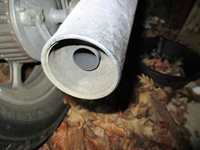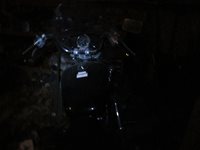During my recent time off for the holidays, I was caught up in an episode of one of my favorite shows…Mythbusters! During this particular episode the myth that motorcycles are greener for the environment than their four-wheel counterparts came under fire. Here in California, as well as other metropolitan areas, people are switching from cars to motorcycles at an alarming rate. There are many reasons for this switch including reducing fuel costs, being able to “split” lanes in traffic, and of course the fact that many think they are “greener” for the environment. Let me go on the books as being in favor of the exhilaration and fun that riding a motorcycle can give a rider. I too think the feeling of riding a bike through the canyons on a nice day is both relaxing and invigorating. What this test did prove is that if you are trying to ride on two wheels to push the “green” initiative, you may be shooting yourself in the foot!

With trucking emissions being under the microscope in recent years, especially here in California, I thought it only fair to argue that the finger pointing in our direction may not be all it is cracked up to be. Perhaps some of the other major industries out there should have their fair share of scrutiny from the lawmakers when it comes to dangerous emission levels too. This led me to dig a little further into the facts of this particular idea. According to the real-time usage data collected for Mythbusters by the University of California Riverside, the polluting emissions were drastically higher for the motorcycles pretty much across the board.
Similar to the response from the trucking industry when emission questions and the thought of regulations first surfaced, riding communities soon came up in arms about the news that bikes were dirtier for the environment than cars. Every biking and riding forum came up with its own reasons why the findings were not accurate. However, facts soon came out and began to multiply in defense of the case study by the Mythbusters and UC Riverside. CARB themselves verified that even though the nearly 600,000 motorcycles in California are only used part-time and account for only 1% of total annual vehicle miles driven in the state, they actually account for nearly 13% of the states hydrocarbon emissions from registered passenger vehicles. It is amazing to me that such a small fraction of the registered vehicles could have such an impact on the pollution for the entire state!
One positive fact that I would like to point out is that the motorcycle industry has done some things to make bikes cleaner since the 2000’s. They have become cleaner by adding things such as fuel injection and charcoal filters to reduce the final output of exhaust gasses, but have not been mandated to do much else in terms of pollution control. What I find most interesting is the stance that the Air Resources Board themselves take on their approach to emission control regulations on motorcycles. "Our strategy with motorcycles has always been to control them to what's cost-effective and technically feasible, and that's always lagged behind cars," said pollution specialist John Swanton with the Air Resources Board. Where was this cost-effective philosophy when it came to the CARB Truck and Bus Rule? It is due to this “cost-effective” approach that the motorcycle industry has remained under pretty “laxed” emissions standards due to the increase in final price to the consumer it would entail. Too bad the price to the consumer wasn’t something taken into consideration for the CARB regulations we have undergone in the trucking industry, seeing as how the average price of trucks has steadily risen since the introduction of emission regulating technology.
My own research into the issue, acquired from the “State of California Department of Motor Vehicles Statistics for Publication,” revealed some more interesting facts. Of the nearly 32,000,000 registered vehicles operating in the State of California, over 800,000 are motorcycles. This doesn’t seem like a lot, but when compared to the fact that only around 1,800,000 trucks operate in the state (441,000 CVRA intra-state/59,000 CA-based IRP trucks/1,300,000 foreign-based IRP trucks). As a reminder, the foreign-based trucks are not even full-time California operating trucks. However, those that do enter California on a regular basis have the CARB rules to deal with as a price to doing business in the state as well.

Even though there are half as many motorcycles registered here as there are trucks, it leaves me wondering how much emissions this is responsible for in comparison to that of the trucking industry and automobile industry footprints? After all, the Mythbusters and UC Riverside project measured that even the bike sample representing bikes from the 2000’s produced 416% more hydrocarbons, 3,220% more oxides of nitrogen (NO
x, cause of smog and main compound aimed at in the CARB Truck and Bus Rule), and 8,065% more carbon monoxide than the car sample tested that represented the same era. Just the NO
x levels alone for the bikes registered in California would be equivalent to that of over 2,500,000,000 cars! Perhaps fuel efficiency gains might be seen by adding certain engine controls to make bikes more efficient, as we have seen in some of the newer truck technologies. Like I mentioned in the beginning of this article, I am all for a nice cruise on a warm, sunny day! With some of the other pollution causing industries out there being overlooked in the watchful eye of the EPA and Air Resources Board, perhaps it is time re-think the solution and to shine the negative spotlight elsewhere for a change!